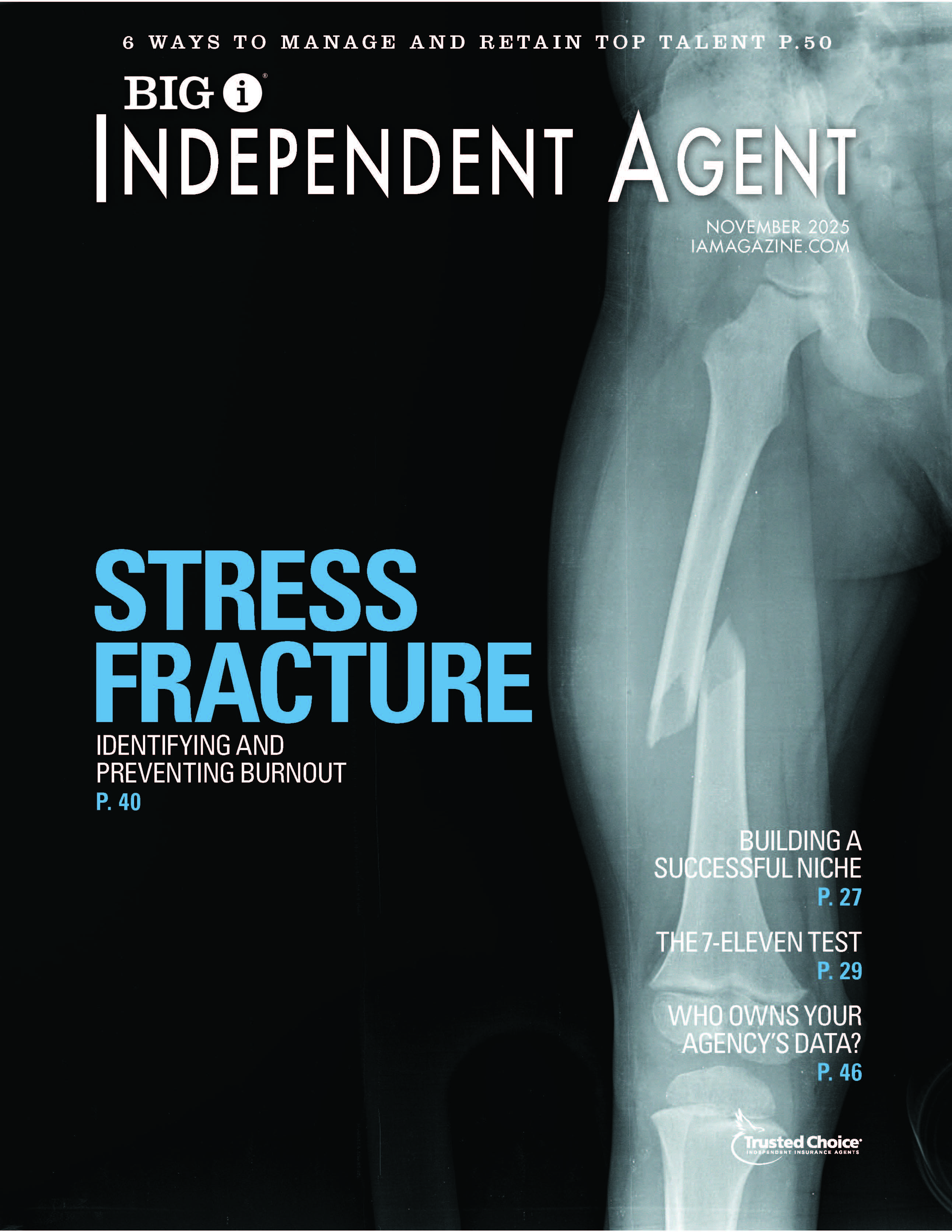Industry Checkup: Room for Improvement

By: Russ Banham
While the number of independent agencies has remained relatively steady in favorable business conditions, agents are still struggling to fill the perpetuation gap, according to the 2016 Future One Agency Universe Study.
Every two years, the Future One Coalition—a partnership between the Big “I” and 17 major insurance companies—dives in to how independent agencies operate, the types of technology and marketing tactics they deploy, their revenue, demographic and compensation metrics, and more. The latest release offers rare insight from nearly 2,000 respondents, from small one-person agencies with less than $100,000 in annual revenue to the very largest, nationwide agencies tallying more than $25 million.
Overall, the 2016 study “puts all the doom-and-gloom predictions of the demise of the independent agency channel in perspective,” says Kevin Jenne, member of the Big “I” Future One Research Task Force and director of agency and consumer insight at Seattle-based insurer Safeco, a Liberty Mutual company. “The agency channel has recovered well from the 2008 recession and is even on the upswing. Buyers continue to find great value in the ease, choice and advice that agents—no one else—can provide.”
But there’s always room for improvement. Here are some of the top findings from the 2016 study—and what they mean for your agency in the year ahead.
Aging Out?
The study reports that the total number of independent property-casualty insurance agencies in the U.S. stands at 38,000. That figure is just slightly lower than the 38,500 agencies tallied in the 2014 survey—not nearly as big a decline as expected in light of the recent uptick in agency mergers & acquisitions.
“The volume of agencies has actually hovered around this number since 2006, give or take a bit,” says Courtney Roberston, senior research director at Zeldis Reseach, which has conducted the survey since 2012. “There was a bit of a slide during the Great Recession, and then a slight increase. But the quantity has stayed relatively steady for the last 10 years.”
However, although 17% of agency principals who own one-fifth or more of their agencies are 66 or older, the vast majority of agencies (81%) do not anticipate a major ownership change over the next three years—and 20% say “lack of available talent is a key barrier to their imminent succession plans,” Robertson says.
That means the perpetuation gap is not necessarily the result of lack of trying. Sean Anderson, member of the Future One Research Task Force and director of enterprise customer research at The Hartford, notes that 79% of principals have developed perpetuation plans for passing the baton at some point in time: “It’s not as high as we’d like to see this percentage, but the overwhelming majority of owners are nonetheless preparing for it.”
Plus, the study suggests the aging of the workforce may be slowing down. Through the past five studies, the age of agency leaders increased at the same pace as the study’s two-year span—for example, the average age of 54 in 2012 increased to 56 in 2014.
“This year is the first time since 2010 when the age of principals actually decreased—to 55,” Anderson says. “While not statistically significant, it is meaningful that the age hasn’t gone up. Leadership is beginning to be handed over to younger individuals.”
Staying Strong
Nearly three-quarters (74%) of survey respondents reported an upsurge in revenue, compared to 70% in the previous study and 42% in the 2012 report. Madelyn Flannagan, vice president of research, education and agent development at the Big “I,” attributes the rise in income primarily to the improved U.S. economy.
“Lots of small businesses have started up and companies are hiring,” Flannagan explains. “Overall, the business marketplace for agencies is better, including in personal lines. This tells us that many insurance consumers are using the internet to flatten their learning curves, but going to an agent to actually buy coverage.”
Fewer agencies are resorting to using market access providers, too: According to the study, while 72% still turn to these solutions to access insurance markets, overall use has declined from 80% in the prior survey.
“Lots of small startup agencies seem to be able to get direct company appointments, without the need to go to a market access provider,” Flannagan says. “For carriers to make these appointments means the agencies have sufficient business models and pretty good marketing plans.”
Room for Improvement
For Jenne, it’s a red flag that nearly 40% of agencies that don’t leverage social media at all in their marketing efforts. “This is a problem that carriers need to address, leveraging our technology consulting expertise to help agents take advantage of social media marketing opportunities,” he says. “The agents that do this well have great lead generation, are able to keep their customers informed and have developed high-touch client relationships.”
Jenne also thinks the finding that agents place twice as much emphasis on retaining business as generating it is “very interesting,” he says. “Carriers tend to focus our marketing on bringing in new business. As good partners, we also have to better assist agents to hold on to the business they have. For instance, when rates rise, we should help them explain to a customer why the premium went up, in a context that is transparent and thoughtful.”
Anderson, meanwhile, is most struck by the finding that 59% of producers sell both personal and commercial lines insurance, while the remainder sells one or the other line of business. “It’s important for us to be sure when building our technology platforms and service models to take into account that most producers wear both hats,” he says. “We can do more to help agents in their cross selling and give them a more seamless experience flowing across both insurance lines.”
The impact of emerging insurance purchase channels is another key agency concern. Altogether, one-third of agencies believe direct purchase of insurance through carriers will have a significant impact on their agencies; the concern is highest among small agencies at 43%.
“This is the first time we asked this question, and it indicates that many agencies are very concerned about the direct sale of insurance—that carriers will offer it and consumers will be interested,” Roberston says.
Challenges identified in earlier studies remain problems today, including underrepresentation of women and people of color at many firms: According to the study, 84% of agency principals and senior managers are men, and 90% are white. While this year’s study reports more women (73%) in non-principal agency management roles, 85% of the employees in these positions are white.
“The Big ‘I’ Diversity Task Force is working hard to improve these percentages, and we’re beginning to see some progress,” Flannagan says. “Obviously, we need to work even harder to assist women and people of color to get carrier appointments. As the ownership of agencies change hands in future, I believe we’ll see an uptick in the number of women and non-white people assuming more senior management roles.”
“Many non-white principals are unaware of Big ‘I’ programs involving diversity and are less likely to be members of a financial organization,” Robertson agrees. “The industry needs to beef up diversity awareness and outreach.”
Russ Banham, a Pulitzer-nominated business journalist, has been an IA contributor for more than 25 years.
Social ShortcomingsMore than half of respondents (55%) have social media and digital marketing strategies—up from 48% in the previous study. Facebook and LinkedIn are the most frequently used social media channels by far, although 9% and 6% use Google+ and Twitter “often,” respectively. Digital strategies like social media outreach, paperless communication efforts and texting with clients also appear to be particularly prominent among newer agencies. But despite increasing social media marketing, 57% of all agencies still have difficulties marketing themselves effectively on the internet, citing this as one of their three biggest technological challenges. Online marketing is a big concern for 63% of small agencies in particular, which often have fewer resources and receive less carrier support than larger agencies. “They know the social media options that are out there and are starting to use them, but they’re stuck with complicated decisions on how much money, time and effort to invest in these marketing strategies,” surmises Courtney Robertson, senior research director at Zeldis Research. Madelyn Flannigan, vice president of research, education and agent development at the Big “I,” agrees that cost is an issue for many agencies. “If they don’t have social media marketing expertise in house, they’re not sure how much they should spend on it, relative to the expected return on the investment,” Flannigan explains. “For the larger agencies, this is less of an issue. But for smaller businesses, just the cost of search engine optimization can be off-putting.” —R.B. |










